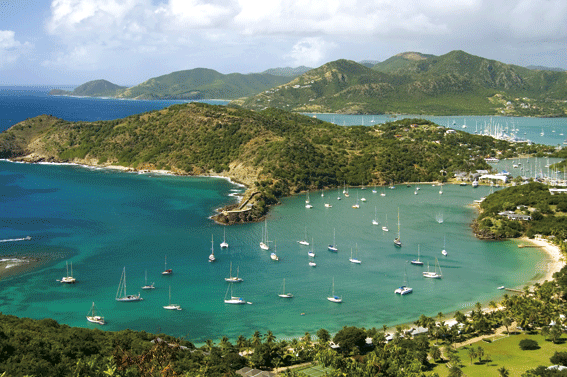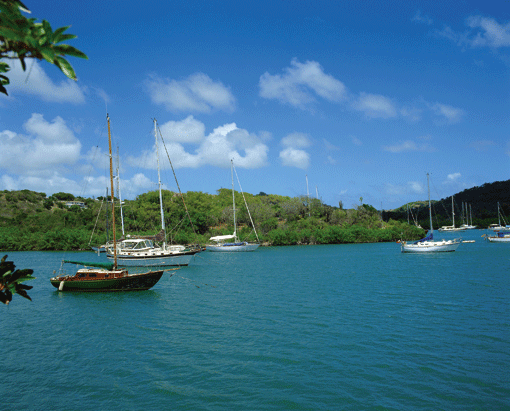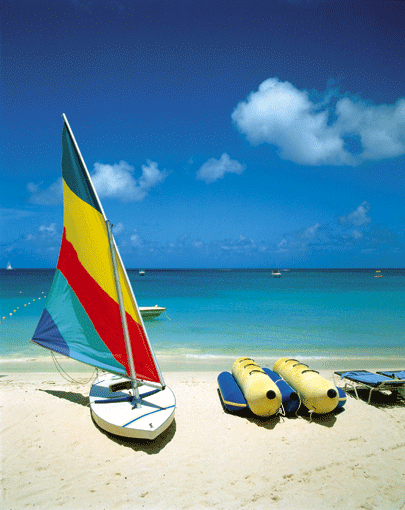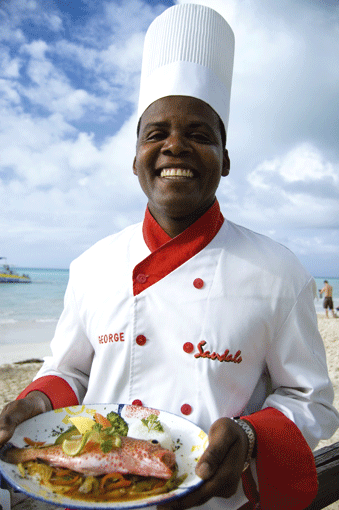
Travel
Awesome Antigua
A Caribbean Coral Island

Antigua offers the rolling hills and welcoming contours of some 365 sandy beaches,
one for every day of the year, it also has sandy coves, graceful harbours
and an abundance of flora and fauna and is rich in history.
By: Veronica Maria Garbutt
Awesome Antigua and the other half of this dual-island nation, Barbuda, are shimmering coral based outcrops in the Caribbean. Part of the Leeward Islands which lie between the mountainous Windward Islands to the south and the Virgin Islands to the northwest, Antigua offers the rolling hills and welcoming contours of some 365 sandy beaches. Plus sandy coves, graceful harbours, an abundance of tropical flora, fauna and colonial era windmills and plantations. Some 40 km south is sparsely populated Barbuda, a quiet single village island popular with birdwatchers.
The island state’s population is around 70,000 and at 180 sq km amoeba-shaped Antigua is the largest of the Leewards. The Atlantic side, beaten by waves down the years, looks pitted and scarred, but on the calmer Caribbean shores, gentle wave action has beached abundant white sand. A high proportion of the islands income is today derived from tourism, roughly split between cruise passengers and hotel guests. Recently there has been something of a mini-boom with much bustling of new houses, government buildings, clinics and hospitals.
Some 4,000 years ago Stone Age Ciboney people came to Antigua from South America. And 2,000 years later came Arawak Indians along with pottery and plants such as papaya, pineapple and tobacco. For a thousand years these people farmed and fished until the Caribs appeared on the scene. Columbus sighted the island in 1493 but it was the British who colonized it, establishing a base at Parham. By the mid-17th century CE Sir Christopher Codrington arrived and introduced sugar plants and processing at Betty’s Hope.
For the next two centuries, sugar was the basis of the economy, bringing great wealth to the planters. As the Caribbean territorial wars were fought between European powers, the British chose Antigua for their military and naval base in the Leewards. By the 19th century CE the wars were over and the abolition movement outlawed slavery in 1834. The sugar industry declined and it was not until 1981 that the island achieved independence. Sir Vere Cornwall Bird became Antigua’s first prime minister.
Over the past 25 years Antigua has established itself as a financial centre for international banking services. New legislation has paved the way for improved products and services including international business corporations, trusts and foundations. On the investment front corporations registered on the island benefit from a tax rate of 30 per cent. And tax holdings are available to certain manufacturing companies under the Air & Pioneer Industries. This, complete with the availability of secure online banking and e-business solutions makes the state a good place to develop international business.
The best way to get around is by car or taxi. There are about a dozen car hire agencies at the airport and a rental car goes for approximately US$50 per day. Driving is on the left. As elsewhere in the Caribbean taxis are a little on the expensive side and a ride from the airport to St John’s costs about $25; to English Harbour $35. Privately owned buses serve several centres and a lot of fun – and cheap too. However, there is no bus service to many northern parts of the island – or to and from the airport and Barbuda has no public transport.
First stop is St John’s which is built around the largest of the island’s natural harbours. With a population of around 30,000 it is certainly not the prettiest Caribbean capital but has much charm in its old stone buildings and higgledy gingerbread houses. Redcliffe Quay is an attractive area full of restored historical buildings—houses and warehouses with stone foundations and clapboard uppers, many with gaily painted shutters and louvers.
The National Museum, located in the Old Court House, houses an exhibition of Amerindia Antigua while the Museum of Marine and Living Art showcases shipwrecks, shells and pre-Columbian history. Heritage Quay is where the cruise ships dock and is home to wooden boardwalk, duty free shops, open air restaurants and cafes and the only toy shop in town. A short drive west of St John’s is the ruins of Fort Barrington on a promontory at Goat Hill overlooking Deep Bay and the Entrance to St. John’s Harbour. This was the site of much conflict between the English and the French for possession in the 17th century CE.
The area north of St John’s is the most developed—both by the tourist industry with deluxe resorts such as Sandals Antigua Grande at Dickenson Bay—and by wealthy Antiguans who have built villas set in frangipani and hibiscus filled gardens. Sandals ( HYPERLINK “http://www.sandals.com” www.sandals.com) is filled with the charm of the islands in its lush garden oasis known as the Caribbean grove. It is also resplendent with European grandeur in its Mediterranean village and offers several restaurants from Japanese to American southwest, along with all types of sports and swimming pools. Further east near the airport are two notable foreign exchange earners, the Export Processing Zone and the American University of Antigua which specialises in medicine.
Travelling east from St John’s on the Old Parham Road you will pass through the lowlands that were formerly covered with canefields. Just off the main road to Indian Town Point lies Betty’s Hope, one of the oldest sugar plantations on the island. Built in 1650 CE and formerly owned by the Codrington family, the plantation has been restored by the Antigua Museum. One of the windmills is now working again and the visitor centre tells the story of plantation life. A little further on is Devil’s Bridge, National Park a natural span cut out of the rock in this National Park. When the waves crash through blowholes here it makes for a dramatic sight.
On the south coast lies English Harbour with its dockyard named after Britain’s Admiral Horatio Nelson. Within are all the facilities which make it a year-round home for yachts and the floating palaces of the rich and famous. The only existing working Georgian dockyard in the world, this National Park area is home to a museum and several other restored buildings such as the copper and lumber store and the Admiral’s Lane where formerly turpentine, lead and pitch were stored.
To ensure the invincibility of Antigua the great fortifications of Shirley Highlights were built in 1781. Named after Governor General Shirley, the ruins today boast the best and classic view of Antigua. Not far away is the imposing Georgian Clarence House, former residence of Prince William Henry, when he was in command of the Pegasus in 1787. It was here too that Britain’s late Princess Margaret spent her honeymoon.
Many of the islands’ best beaches are on the west coast south of St John’s. The Five Islands peninsula has a scattering of comfortable resorts such as the Rex Blue Heron and Hawksbill Beach. Among the hillocks is Green Castle Hill where some unusual rock formations can be found. The coastal road is full of interest and near Swetes village. You can see fields of black pineapple, a small juicy export variety. Near Falmouth is Fig Tree Drive which meanders through a small rain forest with coconut, mango, guava, orange, banana and breadfruit trees at every turn. ‘Fig’ incidentally means banana and this is the islands most bountiful—and beautiful corner.Brochures will tell you that Antigua has 365 beaches, one for every day of the year. So naturally diving and watersports are big. For dedicated sailing and windsurfing enthusiasts Sunsail Club Colonna, on the north coast is the place to head for (www.sunsail.com). Steady Trade winds and a happy laid-back vibe make this report a favourite with intermediate-advanced sailors. And an enclosed yacht harbour gives shelter for beginners who can take advantage of a free RYA Start Sailing course at this resort. Dickenson Bay is the only beach with public hire of watersports equipment, but some hotels will rent out of season. Sandals, all-inclusive resort, admits day visitors at US $110.50 from 10.00-18.00 giving you the use of all sports facilities including canoes, kayaks, windsurfing, Hobie Cats, sail boats, hydro bikes, snorkelling and scuba diving plus meals, drinks and snacks too.
Food in Antigua is a mixture of ‘international fare’ and local West Indian. Some native dishes include breakfast salt fish in tomato and onion sauce, pepperpot with cornmeal dumpling, goat stew, conch and shellfish. Don’t miss the rock line fish with rise and vegetables at Eleanor’s Caribbean restaurant at Sandals Resort. And Hemingway’s, a wooden house with a tin roof and wooden veranda does excellent creole dishes such as pumpkin soup and Bajou flying fish. For Italian cuisine try Alberto’s for real pizzaioli and salmon ravioli with asparagus. And Mid-East Fast Food in St John’s does excellent schwarma, hummus and Arabic bread which you can eat al fresco in the shade.
If you have time to spare don’t miss a trip over to Barbuda, noted for its marine life and beaches. The town of Codrington is centred on the Warden’s House, old pond and cricket ground and is home to the island’s only bank, post office and police station. Codrington Lagoon lies on its border and is a magnet for birds. Here you can take a boat out amid the mangroves to marvel at colonies of frigate birds. Barbuda lies 20 minutes north of Antigua by plane and the ferry service from St John’s Heritage Quay takes one and a half hours. Happy journey!